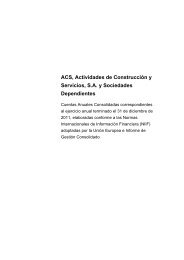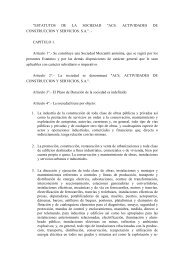Informe de Actividades - Grupo ACS
Informe de Actividades - Grupo ACS
Informe de Actividades - Grupo ACS
You also want an ePaper? Increase the reach of your titles
YUMPU automatically turns print PDFs into web optimized ePapers that Google loves.
El <strong>de</strong>sarrollo<br />
<strong>de</strong> infraestructuras<br />
NORTEAMÉRICA<br />
(c) Nivel <strong>de</strong> inversión en<br />
infraestructuras <strong>de</strong> Estados Unidos<br />
Características y perspectivas macroeconómicas<br />
por áreas geográficas<br />
Porcentaje <strong>de</strong> inversión<br />
(% Inversión sobre PIB 2012e-2016e FMI)<br />
EE.UU.<br />
(c)<br />
16,2%/19,1%<br />
1%<br />
Estados Unidos ha estado invirtiendo en sus<br />
infraestructuras por <strong>de</strong>bajo <strong>de</strong> los niveles <strong>de</strong>l resto<br />
<strong>de</strong> países <strong>de</strong>sarrollados (promedio <strong>de</strong> inversión<br />
en formación bruta <strong>de</strong> capital fijo en el período<br />
2005-2010 <strong>de</strong>l 18,2% sobre el PIB frente al 20,3%<br />
<strong>de</strong> media <strong>de</strong> las economías avanzadas). Esto se<br />
<strong>de</strong>be en parte a la fragmentación <strong>de</strong>l mercado, a<br />
la diferente capacidad inversora entre los Estados<br />
y a la inexistencia <strong>de</strong> un plan <strong>de</strong> infraestructuras<br />
conjunto a nivel nacional.<br />
Así, Estados Unidos, a pesar <strong>de</strong> ser una <strong>de</strong> las<br />
primeras economías mundiales, se ha visto<br />
afectado por una progresiva caída <strong>de</strong> su nivel <strong>de</strong><br />
competitividad tanto a nivel general como en la<br />
calidad <strong>de</strong> su sistema <strong>de</strong> infraestructuras.<br />
(d) Recursos <strong>de</strong> gas natural en<br />
Estados Unidos<br />
Características y perspectivas macroeconómicas<br />
por áreas geográficas<br />
Recursos naturales<br />
(d)<br />
EE.UU.<br />
Estados Unidos, según las estimaciones <strong>de</strong>l<br />
“World Energy Outlook”, se convertirá en 2035<br />
en el segundo mayor productor <strong>de</strong> gas natural<br />
<strong>de</strong>l mundo, sólo superado por Rusia. Más <strong>de</strong> la<br />
mitad <strong>de</strong>l gas natural producido en Estados Unidos<br />
provendrá <strong>de</strong> fuentes no convencionales (gas<br />
Evolución campetitividad<br />
<strong>de</strong> la competitividad en Estados Unidos<br />
Estados Unidos<br />
Posición<br />
0<br />
2<br />
6<br />
4<br />
86<br />
108<br />
12<br />
10<br />
14<br />
16 12<br />
18 14<br />
20<br />
16<br />
18<br />
20<br />
1<br />
7<br />
2008-2009<br />
Posición competitiva global<br />
Posición competitiva infraestructuras<br />
2<br />
8<br />
2009-2010<br />
4<br />
15<br />
2010-2011<br />
5<br />
16<br />
2011-2012<br />
Fuente: “The Global Competitiveness Report” World Economic Forum.<br />
Principales productores <strong>de</strong> gas natural en 2035<br />
Miles <strong>de</strong> millones <strong>de</strong> metros cúbicos<br />
Rusia<br />
Estados Unidos<br />
China<br />
Irán<br />
Catar<br />
Canadá<br />
Argelia<br />
Australia<br />
India<br />
Noruega<br />
0 200 400 600 800<br />
1000<br />
Gas natural convencional<br />
Gas natural no convencional<br />
Fuente: ”World Energy Outlook“, Agencia Internacional <strong>de</strong> la Energía.<br />
34 INFORME ANUAL 2011 DEL GRUPO <strong>ACS</strong><br />
INFORME DE ACTIVIDADES

















